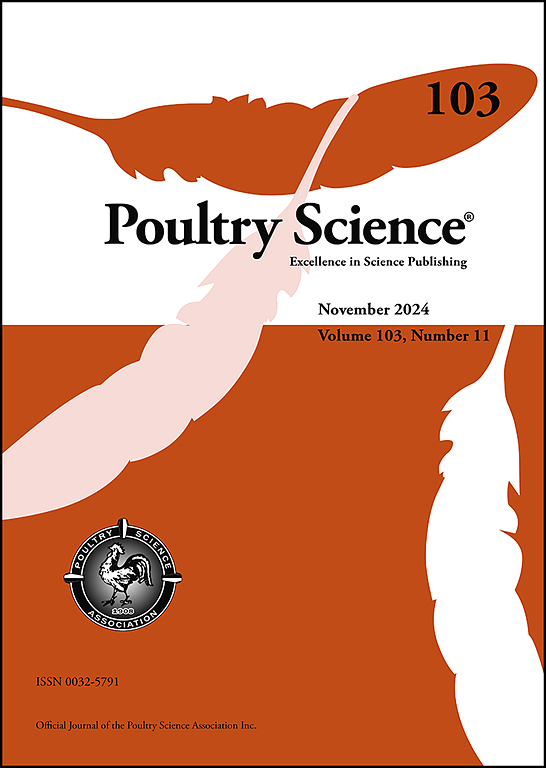Butyric acid from ligilactobacillus animalis 2020MB acts on membrane BamA to control avian pathogenic escherichia coli
IF 3.8
1区 农林科学
Q1 AGRICULTURE, DAIRY & ANIMAL SCIENCE
引用次数: 0
Abstract
Avian pathogenic Escherichia coli can cause high morbidity, mortality, and serious economic losses to the global poultry industry. Lactic acid bacteria inhibit the growth of many pathogens, including E. coli, but the underlying mechanism remains unclear. In this study, we investigated the effect of the cell-free supernatant of Ligilactobacillus animalis 2020MB isolated from the intestinal tract of chickens on specific pathogen-free chickens infected with E. coli. The cell-free supernatant-induced inhibition of E. coli infection was determined through clinical symptom observation, pathological analysis, and qPCR. Protease and heat treatments did not affect the antibacterial activity of cell-free supernatant, suggesting that an organic acid was the antibacterial substance. Liquid chromatography–mass spectrometry and non-targeted metabolomics identified antibacterial activity for eight L. animalis 2020MB cell-free supernatant metabolites, including butyric, valeric, and succinic acids. The inhibitory activity of butyric acid was quantified by determining the minimal inhibitory concentration. Scanning electron microscopy, laser confocal microscopy, and proteomic analysis revealed that butyric acid altered the morphology and impaired the cell envelope integrity of target bacteria, leading to leakage of intracellular contents. BamA was identified as the membrane protein target for butyric acid. The findings reveal the molecular mechanism of action of L. animalis 2020MB in the chicken intestine against E. coli.
动物脂乳杆菌2020MB丁酸作用于BamA膜控制禽致病性大肠杆菌
禽致病性大肠杆菌可造成全球家禽业的高发病率、高死亡率和严重的经济损失。乳酸菌可以抑制包括大肠杆菌在内的许多病原体的生长,但其潜在的机制尚不清楚。在本研究中,我们研究了从鸡肠道分离的动物脂乳杆菌2020MB无细胞上清液对大肠杆菌感染的特异性无病原体鸡的影响。通过临床症状观察、病理分析和qPCR检测无细胞上清对大肠杆菌感染的抑制作用。蛋白酶和热处理对无细胞上清液的抑菌活性没有影响,提示有机酸是抑菌物质。液相色谱-质谱和非靶向代谢组学鉴定了8种L. animalis 2020MB无细胞上清代谢物的抗菌活性,包括丁酸、戊酸和琥珀酸。通过测定最小抑菌浓度,定量测定丁酸的抑菌活性。扫描电镜、激光共聚焦显微镜和蛋白质组学分析显示,丁酸改变了目标细菌的形态,破坏了细胞包膜的完整性,导致细胞内内容物渗漏。BamA被确定为丁酸的膜蛋白靶点。研究结果揭示了鸡肠中动物乳杆菌2020MB对大肠杆菌作用的分子机制。
本文章由计算机程序翻译,如有差异,请以英文原文为准。
求助全文
约1分钟内获得全文
求助全文
来源期刊

Poultry Science
农林科学-奶制品与动物科学
CiteScore
7.60
自引率
15.90%
发文量
0
审稿时长
94 days
期刊介绍:
First self-published in 1921, Poultry Science is an internationally renowned monthly journal, known as the authoritative source for a broad range of poultry information and high-caliber research. The journal plays a pivotal role in the dissemination of preeminent poultry-related knowledge across all disciplines. As of January 2020, Poultry Science will become an Open Access journal with no subscription charges, meaning authors who publish here can make their research immediately, permanently, and freely accessible worldwide while retaining copyright to their work. Papers submitted for publication after October 1, 2019 will be published as Open Access papers.
An international journal, Poultry Science publishes original papers, research notes, symposium papers, and reviews of basic science as applied to poultry. This authoritative source of poultry information is consistently ranked by ISI Impact Factor as one of the top 10 agriculture, dairy and animal science journals to deliver high-caliber research. Currently it is the highest-ranked (by Impact Factor and Eigenfactor) journal dedicated to publishing poultry research. Subject areas include breeding, genetics, education, production, management, environment, health, behavior, welfare, immunology, molecular biology, metabolism, nutrition, physiology, reproduction, processing, and products.
 求助内容:
求助内容: 应助结果提醒方式:
应助结果提醒方式:


